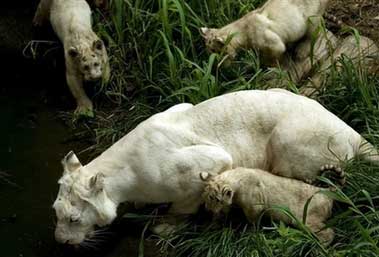Photo of white tigers born in Mexico
Photo of white tigers born in Mexico
mongabay.com
July 5, 2007
Five white Bengal tigers born in April were put on display at the Guadalajara Zoo in Mexico reports the Associated Press.
 AP Photo/Guillermo Arias. |
Four of the cubs are white. It is the sixth litter of white tigers born at the facility — all sired to the same father, named Nino. A white tiger born at the zoo attacked Las Vegas entertainer Roy Horn of the Siegfried and Roy act in 2003. Horn, attacked on his 59th birthday at the The Mirage Hotel in Las Vegas, suffered serious injuries that required more than 3 years of rehabilitation.
White Bengal tigers are not albino. They are Bengal tigers with a genetic variation that causes their normally orange fur to be white in color. According to Wikipedia, white tigers are born larger, grow faster, and attain larger adult sizes than orange tigers. Stripeless or snow white tigers are also known to exist.
The gene for white fur is recessive, meaning that captive white tigers are usually inbred to retain their color between generations.
Related
Tiger parts trade must be banned to save great cats
(6/5/2007) Trade in tiger products must be banned if tigers are to survive in the wild, reports a study published in Bioscience. The paper, The Fate of Wild Tigers, characterizes the decline in wild tiger population as ,catastrophic, and urges governments to outlaw all trade in tiger products from wild and captive-bred sources as well as step up conservation efforts.
Saving big cats depends on science, practical interventions
(5/21/2007) Big cats are some of Earth’s largest and most threatened predators. Long persecuted as perceived threats to livestock and humans, hunted for their skins and purported medicinal values, and losing critical habitat to deforestation and conversion for agriculture, big cat populations have dwindled around the world for the past century. Given these trends, it should come as no surprise that big cats have become the focus of conservation efforts. Not only are large predators often the most vulnerable to human pressures and the first to disappear from ecosystems, but efforts to conserve them effectively help protect thousands of other species that share their habitat. At the forefront of these efforts in Dr. Luke Hunter, a biologist with the Wildlife Conservation Society (WCS) where he heads their Great Cats Program. In a May 2007 interview with mongabay.com, Hunter discussed strategies for conserving carnivores and offered insight for students interested in pursuing careers in conservation science.
Orangutans and tigers become playmates
(2/28/2007) A pair of month-old Sumatran tiger twins have befriended a pair of young orangutans reports the Associated Press (AP). The animals share a room in the nursery at Taman Safari zoo in Sumatra. The AP reports that the animals, which were orphaned, ‘cuddle’ and play together.
Indo-Chinese tiger spotted in China for first time in years
(6/13/2007) Scientists captured a wild Indo-Chinese tiger on film in a nature reserve in Chinaââ¬â¢s southeastern Yunnan Province, reports the Worldwatch Institute.